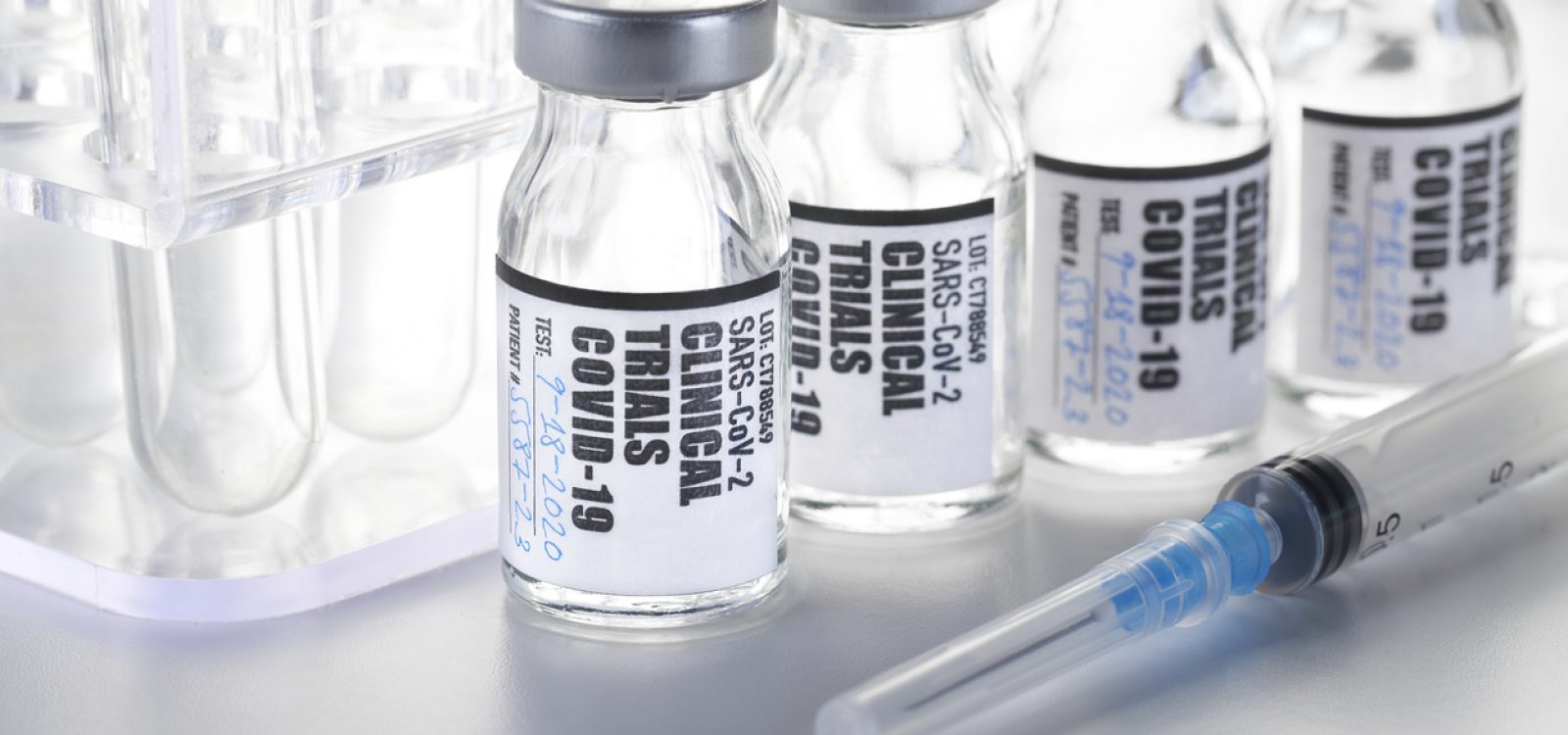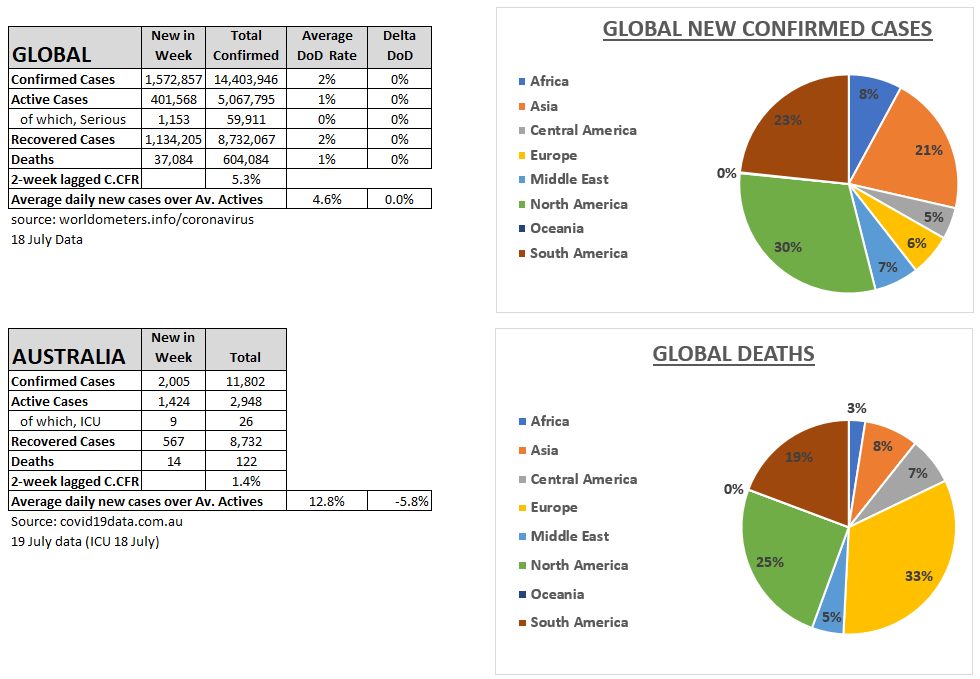
Covid-19 Blog
COVID-19 Monday Roundup 20 July 2020
In a week dominated by growing case numbers and in Australia, poor economic news, lockdowns and mandatory face masks in Melbourne, there were a few bright spots. Vaccine development continues apace, we’re getting better at treating COVID-19 and mental health may have started to improve in Australia. Two COVID-positive hair stylists in the US inadvertently showed that face masks work when they avoided infecting any of 139 clients.

World Summary – 18 July
- Despite a record week of new cases, the acceleration of the pandemic slowed a little this week, following the previous week’s record number of new cases.
- 60% of new cases were in the USA, Brazil and India; nearly 30% were in just 19 other countries with over 10,000 new cases each, headed by South Africa with 87,000, 5.5% of the weekly total.
- The US outbreak keeps increasing linearly, with no sign of flattening off. Deaths are also starting to follow case numbers up, albeit less steeply than the cases themselves. Increasingly, reports are coming through of mortuary and hospital facilities nearing their limits. IHME project ¼ million deaths by 1 November.
- Global deaths were the 5th highest in any week at 37,084, while daily deaths have been increasing steadily since the end of May. Brazil, USA, India and Mexico accounted for 57% of all deaths, an outcome of their large case numbers more than higher death rates, except for Mexico which has death rates near those of Western Europe.
- In addition to the US and India, there are uncontrolled outbreaks in countries in South and Central America and Africa. Brazil may have peaked in their outbreak. In Europe, Russia is bringing their outbreak down very slowly, and in the Middle East, most outbreaks are controlled again or heading towards control.
- Melbourne and Israel are current case studies in how easily this virus can break out of control and inflict new devastation.
Australia Summary – 19 July
- Victoria dominates the Australian situation with 2010 new cases, 95% of all new cases in Australia this week. Worryingly, there are multiple cases in several Victorian aged care facilities.Spread to multiple locations in Sydney, regional Victoria and regional NSW has prompted wider lockdowns in Victoria, new border closures, delayed border openings, and some limited tightening of restrictions in NSW. Face masks are being promoted by health authorities as a means to slow the spread and will be mandatory in Melbourne and the Mitchell shire from Wednesday night
- NSW had 91 new cases, many linked to the Melbourne outbreaks. While there were just four cases where the transmission source has not yet been identified, NSW is on high alert given how rapidly the Melbourne outbreaks have been able to spread.
- WA had 14 new cases and Queensland and SA just one case each, none from unknown sources.
- Average daily testing is now up to nearly 60,000, and the discovery rates have risen to 0.5%.
- According to Citimapper’s mobility index (18 July data), Sydney’s mobility is unchanged, but Melbourne has plunged to 12% of pre-pandemic mobility as a result of the renewed lockdown.
Key market update
- RBA kept interest rates at 0.25% in July, with Governor Philip Lowe stating that the economy is experiencing its largest economic contraction since the 1930s.
- Official unemployment rates rose from 7.1% to 7.4% in June, underpinned by an increase in part-time employment. Payroll jobs are still 5.7% lower than mid-March, with about 35% of jobs lost being regained by the end of June.
- The OECD urges action to avoid a social crisis, highlighting that women, young people and workers on low incomes are being hit hardest by job losses.
- New home loan commitments fell by 11.6 percent in May, driven by strong falls in NSW and Victoria.
- The Federal Government will invest $2 billion in JobTrainer to support training and re-skilling, as well as a further $525 million jointly with the Victorian government to support construction
- Approximately five million Australians will receive a second $750 economic support payment at a cost of $3.8 billion in July.
- In workers compensation, icare shares the challenges COVID-19 is placing on availability of employment and return-to-work rates, as well as the increased support for employers and injured workers returning to work.
- Banks have extended the six-month repayment holiday by another four months. APRA has extended temporary capital treatment for bank loans with repayment deferrals, as well as temporarily adjusting the capital treatment of loans where terms are modified or renegotiated (‘restructured’), and published data on deferrals to date. An FAQ provides guidance to authorised deposit-taking institutions in repurchasing loans from securitisations in response to COVID-19 repayment deferrals.
- ASIC has provided further information on focus areas for financial reporting for companies with year end 30 June 2020.
- The FSC’s has extended the COVID-19 Commitment to Frontline Healthcare Workers until 27 September, ensuring that frontline healthcare workers are not prevented from obtaining life insurance cover purely through exposure, or potential exposure, to coronavirus.
- Swiss Re predicts global insurance premiums to recover in 2021 after contracting this year on the back of a COVID-19-induced recession
- The capital strength of global insurers have proven resilient during the first wave of COVID-19; however capital buffers will erode through the second half of the year, particularly for industrial lines re/insurers, according to S&P.
- PwC is publishing a series of articles that consider opportunities to reform the Australian tax system in the COVID-19 environment of ongoing government support relief measures.
- Deloitte’s Business Outlook: Fast Crisis Slow Recovery, considers what will come next for the Australian and World Economies.
New COVID-19 research this week
- Trials of potential vaccines continue apace, with Moderna’s mRNA-1273 vaccine showing positive Phase I results, Oxford University reporting a ‘breakthrough’ and The University of Queensland starting human trials. The US has narrowed its focus to five potential vaccines. 75 countries have expressed interest in joining the COVAX-Facility, which offers affordable access to successful vaccine candidates in return for an upfront commitment to purchase a pre-defined number of vaccine doses. These countries partner with up to 90 lower-income countries through voluntary donations to Gavi’s COVAX Advance Market Commitment meaning more than 60% of the world’s population could be affordably covered.
- There’s growing evidence (1, 2, 3) that we are getting better at treating COVID-19 and fatality rates are declining. Research published recently showed the effectiveness of putting patients in the prone position, and treating with the drugs Hydroxychloroquine and Tocilizumab, while the drug Remdesivir was approved for use in Australia.
- Modellers estimate that roughly 530 million infections have been averted by policy actions taken in just six countries, while analysis of 149 countries found COVID-19 incidence fell 13% when any of five physical distancing interventions were implemented (though closing public transport added little when other interventions were in place). This pre-print study suggests women-led governments have been more effective at managing the pandemic, with fewer COVID-19 deaths per capita and greater success in flattening the first wave.
- The WHO indicated that SARS-CoV-2 might be capable of airborne transmission. This comes after over 200 scientists wrote to warn of the risk. More countries are now mandating mask wearing.
- Two COVID-positive hair stylists in Missouri infected none of the 139 clients they served while wearing face masks, but four household contacts of the stylists tested positive. 98% of clients interviewed were also wearing face coverings.
- School-aged children are lesser transmitters of COVID-19 than adults. In a study of 49 infected children in Switzerland, in 79% of households at least one adult member already had the virus, while children were the index (first) case in just 8% of households. A German study of 2,000 children found just 12 had antibodies.
- 68% of people tested at an urgent care centre in a working-class neighbourhood in New York had evidence of SARS-CoV-2 antibodies, compared with 13% in a more affluent neighbourhood. More affluent neighbourhoods, could be at greater risk during a second wave. Scientists say seeking herd immunity is unethical after estimates that just 5% of the population in Spain have SARS-CoV-2 antibodies.
- A new viral strain may have emerged in Europe, North America, Australia and Asia, and is more infectious but with similar health outcomes.
- Nearly 90% of 150 discharged COVID-19 patients in Rome reported persistent symptoms two months later, including fatigue, dyspnea, joint pain, and chest pain. Analysis of lung damage in COVID-19 patients who died showed more severe injury to the blood vessels that supply the lungs (endothelial cells) than for influenza; widespread thrombosis (blood clots); and growth of abnormal, new capillaries.
- From April to May, over 16,000 workers (9%) across 239 meat- and poultry-packing plants in the US tested positive for COVID-19, and 86 died. Where data was available, 87% of cases were in racial or ethnic minorities.
- Almost 5% of Australian women respondents to an online survey experienced physical or sexual violence from a current or former cohabiting partner in the past three months, and two-thirds of those said it had escalated since the COVID-19 pandemic.
- Mental health has been affected very differently for Australian employees of different industries, with the media and telecoms industries most affected. The Melbourne Institute propose a range of policy responses. ABS data suggests the easing of restrictions in June has led to an improvement in mental health.
New on the Actuaries Institute website this week.
This work is licensed under a Creative Commons Attribution-NonCommercial-No Derivatives CC BY-NC-ND Version 4.0.
CPD: Actuaries Institute Members can claim two CPD points for every hour of reading articles on Actuaries Digital.






